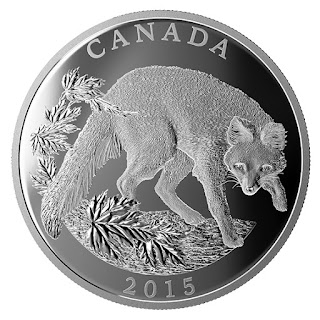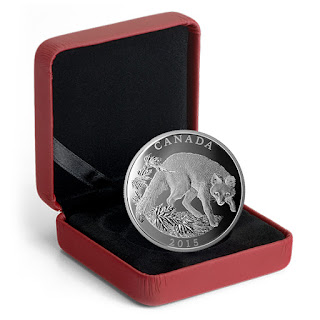Canada 125 Dollars Half Kilogram Fine Silver Coin 2015 The Grey Fox
Conservation Series
This coin has been expertly crafted with a variety of finishes to create its spectacular portrait of a grey fox—standing on a branch. That's right, this nimble fox can climb trees! It can reach heights up to 18 m, and is known to jump from branch to branch. This fascinating and rare animal can only be found in southern Manitoba, Ontario and Quebec, with only one known breeding population on Pelee Island (Ontario).
Obverse: Susanna Blunt’s design of Her Majesty Queen Elizabeth II.
Reverse: The reverse design by Canadian artist Laurene Spino features a full-body portrait of a grey fox standing on a maple bough. This lovely image captures the silent intensity of this extremely efficient predator. Viewed from its right side with its face turned toward the viewer, the furry fox stands poised to pounce from the bough on which it stands, its front left paw raised and ready for action. A variety of engraving and finishing techniques highlight the grey fox's unique physical traits, including its masked eyes, dark back, tail stripe, and long legs. The left side of the image includes several branches of feathery maple leaves, underscoring the grey fox's Canadian presence.
Mintage: 500.
Composition: 99.99% pure silver.
Finish: proof.
Weight: 500 g.
Diameter: 85 mm.
Edge: serrated.
Face value: 125 Canadian Dollars.
Artist: Laurene Spino (reverse), Susanna Blunt (obverse).
- Exceptionally detailed engraving and a variety of finishes bring this beautiful portrait of the grey fox to life.
- The grey fox is extremely rare in Canada, and the only known breeding population is on Pelee Island, Ontario.
Manufacturer: Royal Canadian Mint.
Urocyon cinereoargenteus—the grey fox—is a unique and rare member of Canada's ecosystem that is found only in southern Manitoba, Ontario, and Quebec. This unique canid, which resembles a red fox but with some notable physical differences, is the only member of the dog family in the western hemisphere that can climb trees.
The pretty grey fox is noted for its grizzled russet, gold, and silvery-grey fur, the black stripe extending the full length of its tail and body, a foreshortened muzzle compared to that of the more common red fox, an exceptionally long tail, and rounded footprints that resemble those of a house cat but which leave claw marks. Averaging between 76 and 113 centimetres in length (including a long tail between 27 and 45 centimetres long) and weighing from 3.5 to 7 kilograms (with males just slightly larger than females), this monogamous fox is known to have only one Canadian breeding population on Pelee Island, Ontario. In Canada, the grey fox's preferred habitat is dense deciduous forest and wetlands. It makes its den in small caves, underground burrows, and tree hollows—including hollows high in trees. It is a highly opportunistic feeder, preying on rabbits, rodents, and other small mammals but also eating fruit and vegetables when they are available.
The grey fox's rarity in Canada may be partly attributable to climate; southern Canada marks the northernmost extent of the species' range and the grey fox is found in much greater numbers in the United States. Believed to have once extended across eastern Canada, the grey fox population contracted notably about 300 years ago, prior to European settlement.
One of the grey fox's most interesting traits is its ability to climb trees. Thanks to sharp claws that are hooked much like those of a cat, the grey fox can climb vertical surfaces to heights of up to 18 metres. It can also jump from branch to branch and descend backwards down a trunk like a domestic cat. The fox uses these abilities to evade predators like coyotes, bobcats, and eagles.
Conservation Series
Whooping Crane Grey Fox Narwhal


